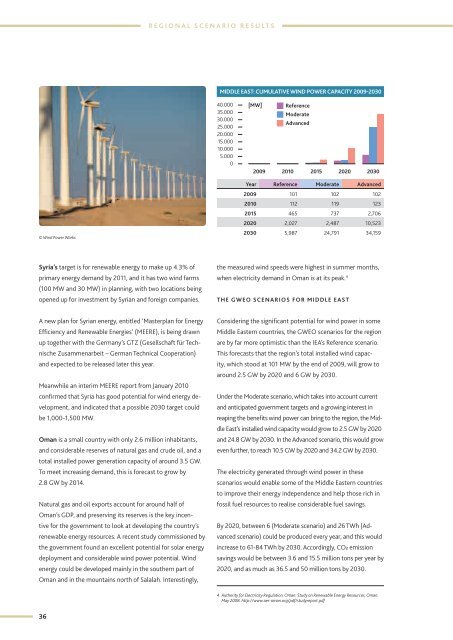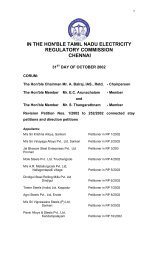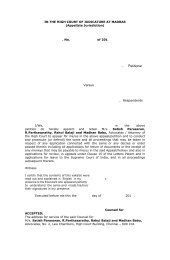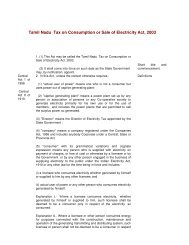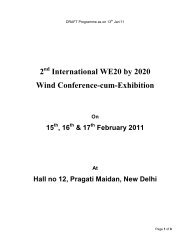glOBal Wind energy OuTlOOk 2010 - Global Wind Energy Council
glOBal Wind energy OuTlOOk 2010 - Global Wind Energy Council
glOBal Wind energy OuTlOOk 2010 - Global Wind Energy Council
You also want an ePaper? Increase the reach of your titles
YUMPU automatically turns print PDFs into web optimized ePapers that Google loves.
R e g i o n a l s c e n a r i o r e s u l T S<br />
Middle EaST: cuMulaTive <strong>Wind</strong> POWer capaciTY 2009-2030<br />
40.000<br />
35.000<br />
30.000<br />
25.000<br />
20.000<br />
15.000<br />
10.000<br />
5.000<br />
0<br />
[MW] Reference<br />
Moderate<br />
Advanced<br />
2009 <strong>2010</strong> 2015 2020 2030<br />
© <strong>Wind</strong> Power Works<br />
Year Reference Moderate Advanced<br />
2009 101 102 102<br />
<strong>2010</strong> 112 119 123<br />
2015 465 737 2,706<br />
2020 2,027 2,487 10,523<br />
2030 5,987 24,791 34,159<br />
Syria’s target is for renewable <strong>energy</strong> to make up 4.3% of<br />
primary <strong>energy</strong> demand by 2011, and it has two wind farms<br />
(100 MW and 30 MW) in planning, with two locations being<br />
opened up for investment by Syrian and foreign companies.<br />
the measured wind speeds were highest in summer months,<br />
when electricity demand in Oman is at its peak. 4<br />
The GWEO scenariOS For Middle EaST<br />
A new plan for Syrian <strong>energy</strong>, entitled ‘Masterplan for <strong>Energy</strong><br />
Efficiency and Renewable Energies’ (MEERE), is being drawn<br />
up together with the Germany’s GTZ (Gesellschaft für Technische<br />
Zusammenarbeit – German Technical Cooperation)<br />
and expected to be released later this year.<br />
Meanwhile an interim MEERE report from January <strong>2010</strong><br />
confirmed that Syria has good potential for wind <strong>energy</strong> development,<br />
and indicated that a possible 2030 target could<br />
be 1,000-1,500 MW.<br />
Oman is a small country with only 2.6 million inhabitants,<br />
and considerable reserves of natural gas and crude oil, and a<br />
total installed power generation capacity of around 3.5 GW.<br />
To meet increasing demand, this is forecast to grow by<br />
2.8 GW by 2014.<br />
Natural gas and oil exports account for around half of<br />
Oman’s GDP, and preserving its reserves is the key incentive<br />
for the government to look at developing the country’s<br />
renewable <strong>energy</strong> resources. A recent study commissioned by<br />
the government found an excellent potential for solar <strong>energy</strong><br />
deployment and considerable wind power potential. <strong>Wind</strong><br />
<strong>energy</strong> could be developed mainly in the southern part of<br />
Oman and in the mountains north of Salalah. Interestingly,<br />
Considering the significant potential for wind power in some<br />
Middle Eastern countries, the GWEO scenarios for the region<br />
are by far more optimistic than the IEA’s Reference scenario.<br />
This forecasts that the region’s total installed wind capacity,<br />
which stood at 101 MW by the end of 2009, will grow to<br />
around 2.5 GW by 2020 and 6 GW by 2030.<br />
Under the Moderate scenario, which takes into account current<br />
and anticipated government targets and a growing interest in<br />
reaping the benefits wind power can bring to the region, the Middle<br />
East’s installed wind capacity would grow to 2.5 GW by 2020<br />
and 24.8 GW by 2030. In the Advanced scenario, this would grow<br />
even further, to reach 10.5 GW by 2020 and 34.2 GW by 2030.<br />
The electricity generated through wind power in these<br />
scenarios would enable some of the Middle Eastern countries<br />
to improve their <strong>energy</strong> independence and help those rich in<br />
fossil fuel resources to realise considerable fuel savings.<br />
By 2020, between 6 (Moderate scenario) and 26 tWh (Advanced<br />
scenario) could be produced every year, and this would<br />
increase to 61-84 tWh by 2030. Accordingly, CO2 emission<br />
savings would be between 3.6 and 15.5 million tons per year by<br />
2020, and as much as 36.5 and 50 million tons by 2030.<br />
4 Authority for Electricity Regulation, Oman: Study on Renewable <strong>Energy</strong> Resources, Oman.<br />
May 2008. http://www.aer-oman.org/pdf/studyreport.pdf<br />
36


